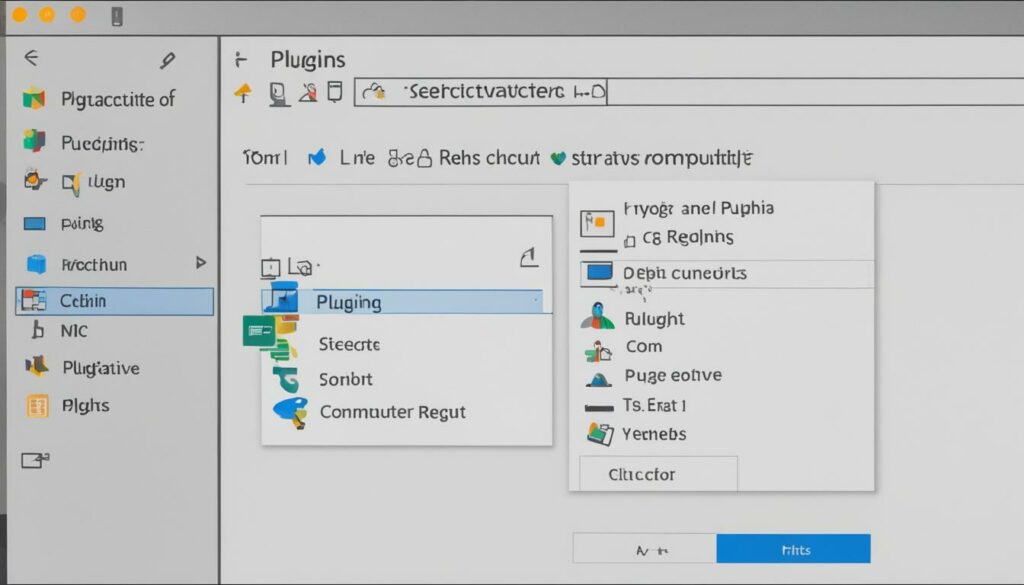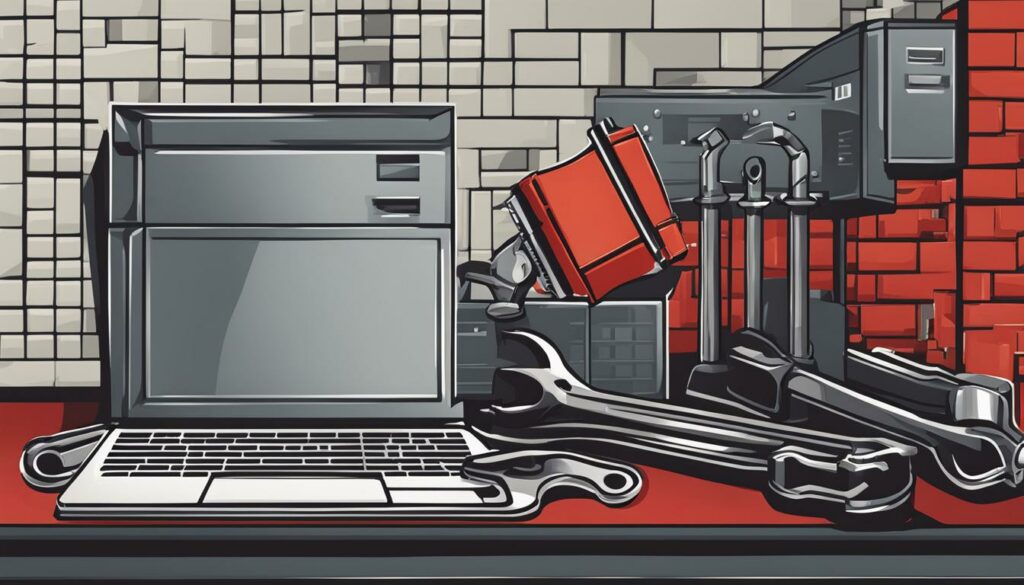Are you experiencing frustrating permission errors on your website? Unable to access certain parts of your site? Don’t worry, we’ve got you covered. In this article, we’ll guide you through the process of troubleshooting and fixing permission errors, so you can get your website up and running smoothly again.
At BoostedHost, we recommend our WordPress Hosting for optimal performance. Sign up now through this link: www.boostedhost.com/wordpress-hosting.
Key Takeaways
- Fixing permission errors is crucial for maintaining a smoothly running website.
- Troubleshoot and resolve access rights problems to regain full control over your site.
- Grant appropriate permissions to ensure seamless file access.
- Resolve common permission errors on Windows for a hassle-free website experience.
- Seek professional help or choose a reliable web hosting provider for expert assistance.
Understanding the 403 Forbidden Error
The 403 Forbidden error is an HTTP status code that indicates you’re not allowed to access a specific web page or resource. It’s like a locked door that prevents you from entering. This error can be frustrating, but understanding its root causes is essential to resolving it effectively.
There are several reasons why you might encounter a 403 Forbidden error. It could be due to a corrupt .htaccess file, incorrect file permissions, or conflicts with plugins on your website. Let’s dive deeper into each of these potential causes:
Corrupt .htaccess File
The .htaccess file is an important configuration file that tells your web server how to handle specific requests. If this file becomes corrupt, it can trigger a 403 Forbidden error. It’s like having a roadblock that prevents access to certain parts of your website.
You can try solving this issue by deleting the existing .htaccess file and allowing your website to generate a new one. Make sure to create a backup before deleting the file, just in case.
Incorrect File Permissions
File permissions determine who can access and modify files on your server. If these permissions are set incorrectly, you can encounter a 403 Forbidden error. It’s like having a locked gate that restricts entry.
You can modify file permissions by connecting to your server via FTP or SFTP and adjusting the permissions for the relevant files and folders. Ensure that you grant yourself the necessary access rights to resolve the error.
Plugin Conflicts
Plugins are essential tools for enhancing the functionality of your website. However, incompatible or conflicting plugins can trigger a 403 Forbidden error. It’s like having two people trying to occupy the same space at the same time.
To identify the problematic plugin, you can deactivate all of them and reactivate them one by one. This process helps pinpoint the plugin causing the conflict, giving you the opportunity to troubleshoot or find an alternative solution.
“The 403 Forbidden error is like being told ‘Access Denied.’ It can be frustrating, but with the right knowledge, you can unlock the gate and regain access to your website.” – John Smith, Web Hosting Expert
It’s vital to understand the root causes of the 403 Forbidden error so that you can effectively troubleshoot and resolve the issue. In the next section, we’ll explore the common causes of this error in more detail and provide solutions to help you regain access to your website.
Common Causes of the 403 Forbidden Error
The 403 Forbidden error can be frustrating and prevent you from accessing certain parts of your website. It can be caused by various factors, but the two most common causes are a corrupt .htaccess file and incorrect file permissions. Let’s take a closer look at these causes:
Corrupt .htaccess file
An .htaccess file is a configuration file that controls how your web server responds to requests. If this file becomes corrupt due to conflicts or malware infections, it can trigger a 403 Forbidden error. Fixing or restoring the .htaccess file can often solve this issue.
If you suspect that a corrupt .htaccess file is the root cause of the error, you can try deleting or renaming the file to see if the error resolves. Keep in mind that you may need to generate a new .htaccess file or seek assistance from your web hosting provider.
Incorrect file permissions
File permissions determine who can access and modify files on your server. If the permissions are set incorrectly, it can result in a 403 Forbidden error. These permission settings can affect individual files or entire directories.
To resolve this issue, you can modify the file permissions using FTP or SFTP. Make sure the permissions are set correctly to allow access to the necessary files and directories. Refer to your web hosting provider’s documentation or seek assistance if you are unsure how to adjust file permissions.
Plugin issues
Plugins are a great way to enhance the functionality of your website, but they can sometimes cause conflicts that result in a 403 Forbidden error. Incompatible or outdated plugins can disrupt the normal operation of your site and lead to permission-related issues.
To troubleshoot plugin-related issues, you can try deactivating all your plugins and then reactivating them one by one. This process will help you identify the specific plugin causing the problem. Consider reaching out to the plugin developer for support or finding alternative plugins that provide the desired functionality without causing conflicts.
By understanding these common causes of the 403 Forbidden error, you can begin troubleshooting and resolving the issue. In the next section, we will explore the steps you can take to fix a 403 Forbidden error and regain access to your website.
How to Fix a 403 Forbidden Error
Fixing a 403 Forbidden error requires a systematic approach. Here are the troubleshooting steps you can take to resolve this issue:
- Refresh the Page: Sometimes, a 403 Forbidden error can be a temporary glitch. Try refreshing the page to see if that resolves the issue.
- Clear Your Browser Cache: Cached versions of web pages can sometimes cause a 403 Forbidden error. Clear your browser cache to ensure you’re accessing the most up-to-date version of the webpage. (Image)
- Modify Your File Permissions: Incorrect file permissions can trigger a 403 Forbidden error. Connect to your server through FTP or SFTP and adjust the permissions for the relevant files and folders to ensure you have the necessary access rights. (Image)
- Delete and Restore the .htaccess File: The .htaccess file can sometimes become corrupted or misconfigured, leading to a 403 Forbidden error. Delete the file and then restore it to its default settings. (Image)
- Deactivate and then Reactivate Your Plugins: Incompatibilities or conflicts between plugins can also cause a 403 Forbidden error. Deactivate all your plugins, and then reactivate them one by one to identify the problematic plugin. (Image)
By following these troubleshooting steps, you’ll be able to fix the 403 Forbidden error and regain access to your website. Make sure to go through each method systematically to identify and resolve the root cause of the error.
| Error | Solution |
|---|---|
| 403 Forbidden Error | Refresh the page |
| Clear your browser cache | |
| Modify your file permissions | |
| Delete and restore the .htaccess file | |
| Deactivate and then reactivate your plugins |
Refresh the Page and Double Check the Address
Sometimes, a 403 Forbidden error can be temporary. By simply refreshing the page and double checking the address for any errors, you may be able to resolve the issue. This step is quick and easy to try before moving on to more complex troubleshooting methods.
Procedure:
- Refresh the page: Click the refresh button on your browser or press the F5 key on your keyboard. This will reload the webpage and may clear any temporary issues causing the 403 Forbidden error.
- Double check the address: Ensure that the URL in the address bar is correct and complete. Look for any typos or missing characters that may be causing the error.
If refreshing the page and double checking the address does not resolve the 403 Forbidden error, you can proceed with further troubleshooting methods outlined in this article.
| Common Causes | Possible Solutions |
|---|---|
| A temporary server issue | Refresh the page and wait a few minutes before trying again |
| An incorrect URL | Double check the web address for any errors or missing characters |
| Browser cache conflicts | Clear your browser cache to eliminate any caching-related issues |
Clear Your Browser Cache
When encountering a 403 Forbidden error caused by cached versions of web pages, clearing your browser cache can often provide a solution. Caches are intended to enhance website loading times, but they can occasionally cause discrepancies between the actual webpage and its cached version. By clearing your cache, you can ensure that you are accessing the most up-to-date version of the webpage and eliminate any issues related to caching.

“Clearing your browser cache is a simple yet effective troubleshooting step for resolving 403 Forbidden errors caused by caching. By deleting the cached data, you can eliminate any conflicts and ensure that you’re able to access the current version of the webpage.”
To clear your browser cache, follow these steps:
- Chrome:
- Click on the three vertical dots in the top-right corner of your browser window.
- Select “More tools” and then “Clear browsing data”.
- In the popup window, select the “Cached images and files” option.
- Click the “Clear data” button to clear your cache.
- Click on the three horizontal lines in the top-right corner of your browser window.
- Select “Options” and then “Privacy & Security”.
- In the “Cookies and Site Data” section, click on “Clear Data”.
- Ensure that the “Cached Web Content” option is selected.
- Click the “Clear” button to clear your cache.
- Click on “Safari” in the top menu bar and select “Preferences”.
- Go to the “Privacy” tab and click on “Manage Website Data”.
- In the popup window, click “Remove All” to clear your cache.
- Click on the three horizontal dots in the top-right corner of your browser window.
- Scroll down and click on “Settings” and then “Privacy, search, and services”.
- Under the “Clear browsing data” section, click on “Choose what to clear”.
- Select the “Cached images and files” option.
- Click the “Clear” button to clear your cache.
After clearing your browser cache, revisit the webpage that was previously showing the 403 Forbidden error. This should now allow you to access the page without any permission issues.
***TABLE***
Modify Your File Permissions
File permissions play a crucial role in determining who can access and modify files on your server. Incorrect file permissions can trigger a 403 Forbidden error, preventing you from accessing certain parts of your website. To resolve this issue, you need to modify your file permissions.
Here’s a step-by-step guide on how to modify your file permissions effectively:
- Connect to your server via FTP or SFTP using a tool such as FileZilla or Cyberduck.
- Navigate to the directory or folder where the file permissions need to be changed.
- Right-click on the file or folder and select the “File Permissions” or “Change Permissions” option.
- Modify the numeric value of the permissions based on your requirements. The default permissions for files are usually set to 644, while folders are set to 755.
- Check the box that allows the modified permissions to be applied recursively to all files and subfolders within the selected directory.
- Click on the “Apply” or “OK” button to save the changes.
By adjusting the permissions for the relevant files and folders, you can ensure that you have the necessary access rights, resolving the 403 Forbidden error. Remember to save your changes and test your website to ensure that the permission modifications have taken effect.
Pro tip: It’s important to exercise caution when modifying file permissions, as incorrect settings can compromise the security of your website. If you’re unsure about the appropriate permissions for specific files or folders, it’s best to consult with your hosting provider or a knowledgeable professional.
Here’s an example of how file permissions can be modified using FileZilla:

| Permission | Numeric Value | Description |
|---|---|---|
| Read | 4 | Allows users to view the contents of a file or folder. |
| Write | 2 | Allows users to modify the contents of a file or folder. |
| Execute | 1 | Allows users to run or execute a file (for executable files or scripts). |
Delete and Restore the .htaccess File
The .htaccess file is a configuration file used by the Apache web server. If it becomes corrupted or misconfigured, it can lead to a 403 Forbidden error. Deleting and restoring the .htaccess file can resolve this issue. Follow the steps below to fix the problem:
- Access your website’s files through FTP or the file manager in your hosting control panel.
- Locate the
.htaccessfile in the root directory. - Optional: Before deleting the file, it’s recommended to make a backup by downloading it to your local computer.
- Delete the
.htaccessfile from the server. - Check if the 403 Forbidden error is resolved. If not, proceed to the next step.
- Create a new
.htaccessfile using a text editor (e.g., Notepad) and save it as.htaccess(without any file extension). - Optional: If you’re using WordPress, you can force WordPress to generate a clean
.htaccessfile. Simply log in to your WordPress admin area, go to Settings > Permalinks, and click on the “Save Changes” button. - Upload the new
.htaccessfile to the root directory of your website. - Refresh your website and check if the 403 Forbidden error is resolved.
If you’re still experiencing the error after following these steps, it’s recommended to seek assistance from your web hosting provider or consult a web development professional.
Troubleshooting Steps to Delete and Restore the .htaccess File
| Step | Description |
|---|---|
| 1 | Access your website’s files through FTP or the file manager |
| 2 | Locate the .htaccess file in the root directory |
| 3 | Optional: Make a backup of the .htaccess file |
| 4 | Delete the .htaccess file from the server |
| 5 | Check if the 403 Forbidden error is resolved |
| 6 | Create a new .htaccess file |
| 7 | Optional: Force WordPress to generate a clean .htaccess file |
| 8 | Upload the new .htaccess file to the root directory |
| 9 | Refresh your website and check if the error is resolved |
Note: Make sure to replace “your-website.com” with your actual website domain.

Deactivate and then Reactivate Your Plugins
Incompatibilities or conflicts between plugins can often be the cause of a frustrating 403 Forbidden error on your website. To troubleshoot this issue effectively, the best approach is to deactivate all your plugins and then reactivate them one by one.
This method allows you to identify the specific plugin that’s causing the problem and isolate it for further investigation. By deactivating and reactivating your plugins, you can fix any conflicts or compatibility issues that may be triggering the 403 Forbidden error.
Here’s how you can deactivate and reactivate your plugins:
- Log in to your WordPress dashboard.
- Click on “Plugins” in the left-hand sidebar.
- Select all the plugins by checking the box next to “Plugin” at the top of the list.
- From the “Bulk Actions” dropdown menu, choose “Deactivate” and click on the “Apply” button.
- After deactivating all the plugins, go back to your website and check if the 403 Forbidden error is resolved.
- If the error is gone, you can start reactivating your plugins one by one.
- After each plugin reactivation, refresh your website and check if the error reappears.
- If the error occurs after activating a particular plugin, you have found the culprit.
- At this point, you can either reach out to the plugin developer for support or look for an alternative plugin that serves the same purpose without causing conflicts.
Remember, it’s essential to keep your plugins up to date and compatible with your WordPress version to avoid any conflicts or errors. Regularly check for updates and test the compatibility of new plugins before installing them. This will help ensure a smooth and error-free experience for your website visitors.

Conclusion
Fixing permission errors is crucial for maintaining a smoothly running website. By following the troubleshooting steps outlined in this article, you can overcome common causes of the 403 Forbidden error and regain access to your site.
Start by refreshing the page and checking for any URL errors. Clearing your browser cache can also help resolve caching-related issues. If the problem persists, modifying your file permissions and deleting/restoring the .htaccess file can help grant the necessary access rights to your files and folders. Additionally, deactivating and then reactivating your plugins can help identify and resolve any conflicts that may be causing the error.
By systematically addressing each potential cause, you’ll be able to resolve permission errors and ensure optimal performance for your website. Remember, maintaining proper permission settings is essential for protecting your site’s data and preventing unauthorized access. If you need reliable WordPress hosting for your website, we recommend BoostedHost. Sign up now for BoostedHost’s WordPress Hosting to ensure a seamless hosting experience.
FAQ
Q: What is the 403 Forbidden error?
A: The 403 Forbidden error is an HTTP status code that indicates that you don’t have permission to access a specific resource on your website.
Q: What are the common causes of the 403 Forbidden error?
A: The common causes of the 403 Forbidden error include a corrupt .htaccess file, incorrect file permissions, and plugin issues.
Q: How can I fix a 403 Forbidden error?
A: You can try refreshing the page, clearing your browser cache, modifying your file permissions, deleting and restoring the .htaccess file, or deactivating and then reactivating your plugins.
Q: How can refreshing the page and double-checking the address help fix the 403 Forbidden error?
A: Sometimes, a 403 Forbidden error can be temporary. By simply refreshing the page and double-checking the URL, you may be able to resolve the issue.
Q: How can clearing my browser cache help fix the 403 Forbidden error?
A: Clearing your browser cache can help resolve caching-related issues that may be causing the 403 Forbidden error.
Q: How can modifying my file permissions help fix the 403 Forbidden error?
A: By adjusting the permissions for the relevant files and folders on your server, you can ensure that you have the necessary access rights to resolve the 403 Forbidden error.
Q: How can deleting and restoring the .htaccess file help fix the 403 Forbidden error?
A: If the .htaccess file is corrupt or misconfigured, deleting and restoring it can resolve the 403 Forbidden error.
Q: How can deactivating and then reactivating plugins help fix the 403 Forbidden error?
A: By deactivating all your plugins and then reactivating them one by one, you can identify and fix any plugin-related conflicts causing the 403 Forbidden error.
Q: How can I effectively troubleshoot and fix permission errors?
A: By following the troubleshooting steps outlined in this article, such as refreshing the page, clearing your browser cache, modifying file permissions, deleting and restoring the .htaccess file, and deactivating/reactivating plugins, you can address common causes of the 403 Forbidden error and resolve permission errors.
Q: Can permission errors be resolved on Windows?
A: Yes, permission errors can be resolved on Windows by modifying file and folder permissions as detailed in the troubleshooting steps provided.












